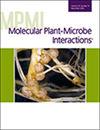Yi Yun Tan, Yin Yin Liew, Rachelle R Q Lee, Baptiste Castel, Nga Man Chan, Wei-Lin Wan, Yizhong Zhang, Donghui Hu, Persis Chan, Sang-Tae Kim, Eunyoung Chae
求助PDF
{"title":"利用拟南芥中的腺嘌呤碱基编辑和 NG-PAM Cas9 生成可遗传的 A-G 转换。","authors":"Yi Yun Tan, Yin Yin Liew, Rachelle R Q Lee, Baptiste Castel, Nga Man Chan, Wei-Lin Wan, Yizhong Zhang, Donghui Hu, Persis Chan, Sang-Tae Kim, Eunyoung Chae","doi":"10.1094/MPMI-10-24-0127-TA","DOIUrl":null,"url":null,"abstract":"<p><p>Towards precise genome editing, base editors have been developed by fusing catalytically compromised Cas9 with deaminase components, mediating C-to-T (cytosine base editors) or A-to-G (adenine base editors) transition. We developed a set of vectors consisting of a 5'-NG-3' PAM-recognizing variant of SpCas9 with adenosine deaminases TadA7.10 or TadA8e. Using a phenotype-based screen in <i>Arabidopsis thaliana</i> targeting multiple <i>PDS3</i> intron splice sites, we achieved up to 81% somatic A-to-G editing in primary transformants at a splice acceptor site with NGG PAM, while 35% was achieved for the same target adenine with NGA PAM. Among tested vectors, pECNUS4 (Addgene #184887), carrying TadA8e, showed the highest adenine base editor (ABE) efficiency. With pECNUS4, we recreated a naturally occurring allele of <i>DANGEROUS MIX3</i> (<i>DM3</i>) in two generations, transgene-free, for NGC PAM. We also simultaneously base-edited four redundant <i>DM1/SSI4</i> homologs, encoding nucleotide-binding leucine-rich repeat (NLR) proteins, using a single gRNA with NGA PAM targeting the conserved yet functionally crucial P-loop motif of NLR proteins. We found fixation of A-to-G in three NLR genes for all three possible adenine sites within base-editing window 3-9, as the edited genes segregate in T<sub>2</sub>. Multigene targeting succeeded in rescuing the previously reported autoimmune phenotype in two generations. Mediating desired ABE on seven NLR genes simultaneously was successful as well; above 77% editing was achieved in six of the seven possible targets in a T<sub>1</sub> plant, with the remaining having a moderately high (32%) editing. ABE application to specifically inactivate functional motifs is anticipated to expedite the discovery of novel roles for proteins. [Formula: see text] Copyright © 2025 The Author(s). This is an open access article distributed under the CC BY 4.0 International license.</p>","PeriodicalId":19009,"journal":{"name":"Molecular Plant-microbe Interactions","volume":" ","pages":"30-42"},"PeriodicalIF":3.4000,"publicationDate":"2025-02-01","publicationTypes":"Journal Article","fieldsOfStudy":null,"isOpenAccess":false,"openAccessPdf":"","citationCount":"0","resultStr":"{\"title\":\"Generation of Inheritable A-to-G Transitions Using Adenine Base Editing and NG-PAM Cas9 in <i>Arabidopsis thaliana</i>.\",\"authors\":\"Yi Yun Tan, Yin Yin Liew, Rachelle R Q Lee, Baptiste Castel, Nga Man Chan, Wei-Lin Wan, Yizhong Zhang, Donghui Hu, Persis Chan, Sang-Tae Kim, Eunyoung Chae\",\"doi\":\"10.1094/MPMI-10-24-0127-TA\",\"DOIUrl\":null,\"url\":null,\"abstract\":\"<p><p>Towards precise genome editing, base editors have been developed by fusing catalytically compromised Cas9 with deaminase components, mediating C-to-T (cytosine base editors) or A-to-G (adenine base editors) transition. We developed a set of vectors consisting of a 5'-NG-3' PAM-recognizing variant of SpCas9 with adenosine deaminases TadA7.10 or TadA8e. Using a phenotype-based screen in <i>Arabidopsis thaliana</i> targeting multiple <i>PDS3</i> intron splice sites, we achieved up to 81% somatic A-to-G editing in primary transformants at a splice acceptor site with NGG PAM, while 35% was achieved for the same target adenine with NGA PAM. Among tested vectors, pECNUS4 (Addgene #184887), carrying TadA8e, showed the highest adenine base editor (ABE) efficiency. With pECNUS4, we recreated a naturally occurring allele of <i>DANGEROUS MIX3</i> (<i>DM3</i>) in two generations, transgene-free, for NGC PAM. We also simultaneously base-edited four redundant <i>DM1/SSI4</i> homologs, encoding nucleotide-binding leucine-rich repeat (NLR) proteins, using a single gRNA with NGA PAM targeting the conserved yet functionally crucial P-loop motif of NLR proteins. We found fixation of A-to-G in three NLR genes for all three possible adenine sites within base-editing window 3-9, as the edited genes segregate in T<sub>2</sub>. Multigene targeting succeeded in rescuing the previously reported autoimmune phenotype in two generations. Mediating desired ABE on seven NLR genes simultaneously was successful as well; above 77% editing was achieved in six of the seven possible targets in a T<sub>1</sub> plant, with the remaining having a moderately high (32%) editing. ABE application to specifically inactivate functional motifs is anticipated to expedite the discovery of novel roles for proteins. [Formula: see text] Copyright © 2025 The Author(s). This is an open access article distributed under the CC BY 4.0 International license.</p>\",\"PeriodicalId\":19009,\"journal\":{\"name\":\"Molecular Plant-microbe Interactions\",\"volume\":\" \",\"pages\":\"30-42\"},\"PeriodicalIF\":3.4000,\"publicationDate\":\"2025-02-01\",\"publicationTypes\":\"Journal Article\",\"fieldsOfStudy\":null,\"isOpenAccess\":false,\"openAccessPdf\":\"\",\"citationCount\":\"0\",\"resultStr\":null,\"platform\":\"Semanticscholar\",\"paperid\":null,\"PeriodicalName\":\"Molecular Plant-microbe Interactions\",\"FirstCategoryId\":\"99\",\"ListUrlMain\":\"https://doi.org/10.1094/MPMI-10-24-0127-TA\",\"RegionNum\":3,\"RegionCategory\":\"生物学\",\"ArticlePicture\":[],\"TitleCN\":null,\"AbstractTextCN\":null,\"PMCID\":null,\"EPubDate\":\"2025/2/25 0:00:00\",\"PubModel\":\"Epub\",\"JCR\":\"Q2\",\"JCRName\":\"BIOCHEMISTRY & MOLECULAR BIOLOGY\",\"Score\":null,\"Total\":0}","platform":"Semanticscholar","paperid":null,"PeriodicalName":"Molecular Plant-microbe Interactions","FirstCategoryId":"99","ListUrlMain":"https://doi.org/10.1094/MPMI-10-24-0127-TA","RegionNum":3,"RegionCategory":"生物学","ArticlePicture":[],"TitleCN":null,"AbstractTextCN":null,"PMCID":null,"EPubDate":"2025/2/25 0:00:00","PubModel":"Epub","JCR":"Q2","JCRName":"BIOCHEMISTRY & MOLECULAR BIOLOGY","Score":null,"Total":0}
引用次数: 0
引用
批量引用

 求助内容:
求助内容: 应助结果提醒方式:
应助结果提醒方式:


